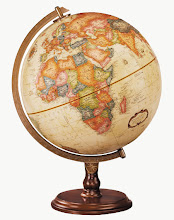

We then took the bus to the Tel of Old Testament Jericho. It was much smaller than I expected it to be and with fewer ruins. It makes you wonder how the Israelite army had room to march around - they would have been spread all over the hills! After Jericho is destroyed, Joshua places a curse on the city, saying, “At the cost of his firstborn son he will lay its foundations; at the cost of his youngest he will set up its gates.” In Judges, the story of Ehud tells us that Eglon, King of Moab had taken possession of Jericho (called the City of Palms in this story), so obviously the curse did not affect him. The curse eventually falls on Hiel of Bethel when he rebuilds Jericho during the time of the divided kingdom.
Leaving Jericho, we headed back up into the Judean wilderness via the "TOE" route (Tayhe Ophrah Ephraim, the names of the town along the route). As we climbed out of the Jordan valley, the views behind us were amazing. We could also see a number of Bedouin settlements and many small crop fields. Looking at the fields - their small size, with plenty of rocks and thorns around - makes the parable of the sower come to life ... I can now visualize what the crowds would have been thinking about when Jesus told them this parable.
We stopped at a lookout to place the towns we were able to see with the towns we had been focusing on in our map work and during class yesterday. Two interesting ideas were presented there. First, the story in Judges about the near annihilation of the tribe of Benjamin. The story may have been written during or just after David's reign, putting a whole new political spin on the story. In the story, the father-in-law in Bethlehem (David's hometown) is made out to be super-hospitable, as opposed to rape and murder of the concubine in Gibeah (Saul's hometown). So, in a way, the story raises up David's credibility while destroying Saul's.

The second topic was the story in Genesis where Abraham and Lot divide the land. In this region, people orient themselves towards the East, so when referring to left and right, they could also be referring to North and South. In that case, Abraham is asking Lot whether he would prefer the north or south half of the promised land, Lot chooses something he wasn't offered - the East (the fertile Jordan valley). In this way, Lot abandons Abraham and leaves the promised land.
Next stop was an unusual overlook of the Central Benjamin Plateau - King Husein of Jordan's unfinished palace! I found it really useful to be able to compare what I'm used to studying on a map to what it really looks like - the plateau isn't as flat as the name makes it sound, but it is much flatter than the surrounding hills and sharp valleys. We also made a quick stop at Nabi Samuel to look over the plateau from a different angle. Looking over the area, it's easy to see why this was such a strategically important area.


We continued our field study exiting the plateau to the west and visiting Tel Gezer - one of the largest archaeological sites in Israel (I would guess at least 4 times the size of Jericho). Gezer controlled the Aijalon Valley, the entrance into Benjamin via the Upper and Lower Beth-horon and Kiriath-jearim ridge routes. Not much is written about Gezer in the Bible, but that is generally the case with important political sites - the more important, the less it's mentioned. During Solomon's reign, Pharoh conquered Gezer and gave it to Solomon as a wedding dowry. Solomon then fortified the city.

 Since we spent the day in the West Bank, we got to see a lot of the wall the Israelis built around it. We had no problems driving through, but cars with Arab-looking occupants were getting searched.
Since we spent the day in the West Bank, we got to see a lot of the wall the Israelis built around it. We had no problems driving through, but cars with Arab-looking occupants were getting searched.



No comments:
Post a Comment